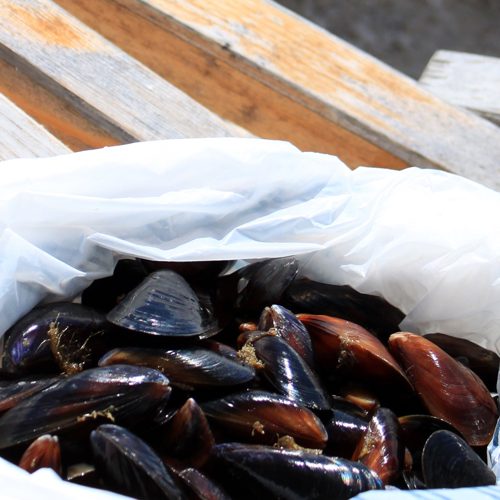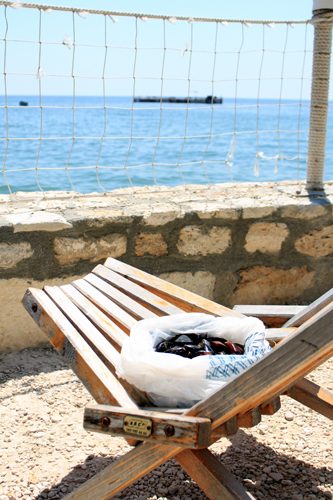Last Updated on February 18, 2022 by Share My Kitchen
We recently moved to a new place and the last few weeks we’ve lived on the Black Sea coast of Bulgaria. This is one of the reasons why you haven’t heard from us for a while.
However, for the not-so-long time we’ve been here, we’ve learned quite a few local recipes, products, and local names for otherwise widely known food-related stuff.

All that impressed us or was in one way or another interesting for us, we’ll share with you here, in our blog.
One of the things we eat a lot lately is mussels. I must confess that mussels are my latest “discovery” and today’s post will be about what we’ve learned about our newly gathered experience in regards to their sourcing, storage, cleaning, and cooking.
Where to Buy Mussels?
You can buy mussels in various places, specialized in fresh or frozen seafood products, but the best place to buy them is from your local fishmongers or even better, from local fishermen or mussel farms. We are lucky to have one very close to where we live now and the type of mussels they produce is Blue Mussels (or Mytilus edulis) – probably the most widely spread around Europe type of mussels.
Getting Fresh Mussels
Fresh mussels must have the smell of the sea. Whether you buy them from the market or a specialized shop, the mussels must be closed and their shells not chipped – thus the chances are they are still alive, and this is what you want. That’s why they usually keep them in net bags and submerged in seawater, so they can breathe.
Because of widespread sea pollution, it’s much safer to buy mussels produced in a clean offshore environment (that of mussel farms) than some harvested anywhere else.
Like other shellfish, fresh mussels are a perishable product; use them as soon as possible after you buy or harvest them. And never buy mussels with chipped or broken shells or opened mussels – they are not alive.
How to check if mussels are still alive?
Mussels are definitely something you want to buy the same day you make it. But how to say if the ones you’ve bought are dead or alive? The best case scenario is when they are closed – you don’t need to worry about them – they are alive. If any of the mussels are a little open, just tap them on the table and see if they will start shutting.
If so, they are alive. I’ll say it again, throw away all that is chopped or broken or were wide open and would not close after tapping them.
After boiling them, do another inspection but this time throw away any that are not opened.
How to store fresh mussels (and keep them alive)?
Storing fresh mussels in your refrigerator with a damp paper towel will prolong the shelf life of the mussels for up to 3-4 days.
The mussels will need plenty of open-air to breathe, and you will have to remove them from any plastic bags to ensure that they can breathe.
Do not freeze them – mussels need to stay alive until you cook them.
Fresh blue mussels, just bought from the mussel farm (on the top of the picture)
How to clean mussels?

Before you cook them, you need to clean them. Rope-grown mussels are usually very clean, but mussels that have been dredged from the seabed will have barnacles on them and grit inside.
1. Place the mussels in the sink under cold running water. Soak them for 10-15 minutes just before you are going to cook them. This way, they will expel any sand, left inside the shell, while breathing.
2. Scrub each mussel clean with a stiff brush to get rid of any barnacles. You don’t want any grit in your rich sauce.
3. Pull off the hairy ‘beard’ that sticks out from the shell, towards the hinge end of the mussel. Pulling out the beard towards the opening end of the mussel can cause tearing it out of the shell, and you don’t want that to happen.
4. Rinse out the cleaned mussels under the running water. Now mussels are ready to be cooked. It’s really important that the water stays moving over the mussels, but that they’re not soaking in it. If you leave them soaking in tap water, they’ll die and that’s not what you want.
How much to buy?
Because you buy mussels with shells, it’s not that easy to know how much would suffice, especially the first time you buy them with shells. We recommend you buy one pound per person if planned as a main dish or half a pound if you going to have them as an appetizer.
How to cook mussels?
Probably the most popular recipe to cook blue mussels is the classic French way, which is with white wine, garlic, shallots, parsley and butter. You only cook them for a short time, just until the shells open.
In the place, we live now (the north part of the Bulgarian Black Sea coast) there are dozens of ways to cook mussels but inevitably all with the use of lovage – a flavourful green spice, that gives the dish characteristic smell and flavor.
Steam mussels
Another popular way to cook mussels is to half cook them by steaming (just until they open their shells) and then continue with another method, such as grilling, pan-frying, or baking.
The most important thing to remember is that no matter what cooking method you use to cook the mussels, it should be less than ten minutes otherwise they become stiff and chewy. So if you are going to add them to rice or pasta dishes, add them last, to avoid overcooking.
How to steam mussels?
- Add one or two glasses of white wine (or water) to the already cleaned mussels. Because they will release their own sauce, do not add too much liquid to the pot otherwise the sauce will become too diluted.
- When the liquid is boiling, reduce the heat, cover and simmer the mussels for 5 minutes, stirring frequently. This should be enough time for them to begin opening. After this time you can remove each mussel as it opens. This way all the mussels will be cooked evenly.
- Throw out any mussels, that have not opened.
- In order to avoid any remains of sand or pieces of shells, you can strain the broth.
- The mussels can be served right away in their shells, with the strained broth, or you can proceed according to the recipe you’ve chosen.
Why mussels are good food?
They are much chipper than their distinguished cousins – the oysters. Research demonstrated that mussels are rich in protein – they actually contain the same quantity, like a T-bone steak, but four times fewer calories and up to eight times fewer fats.
Moreover, the mussels are a good source of vitamins B12 and C, zinc, iron, selenium, phosphorous, and more essential Omega-3 fatty acids than any other shellfish.


